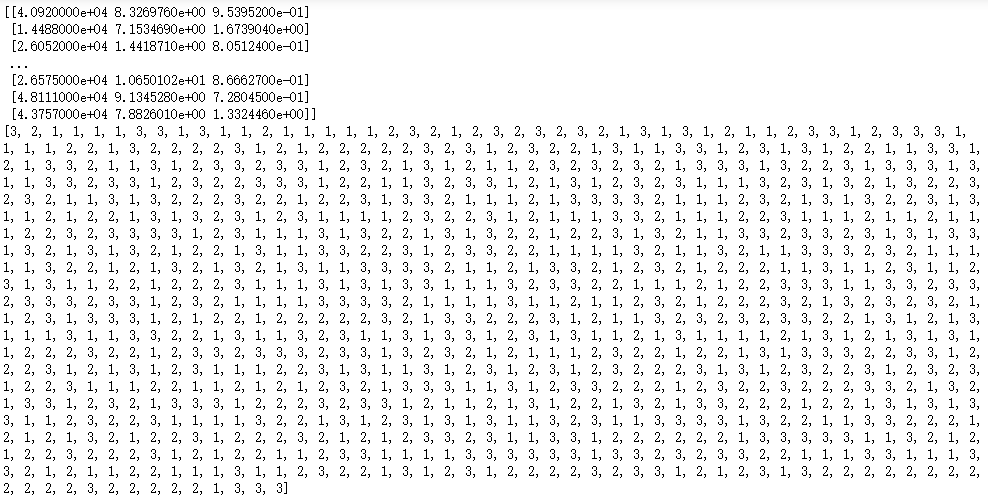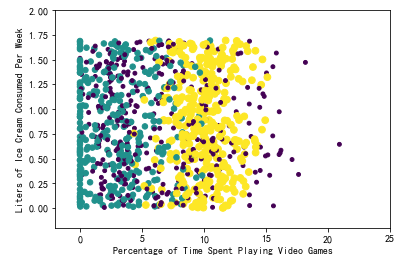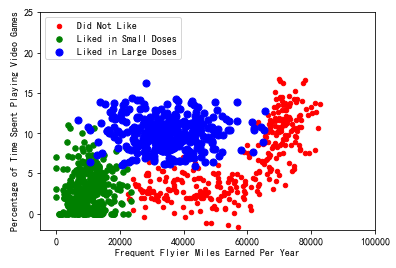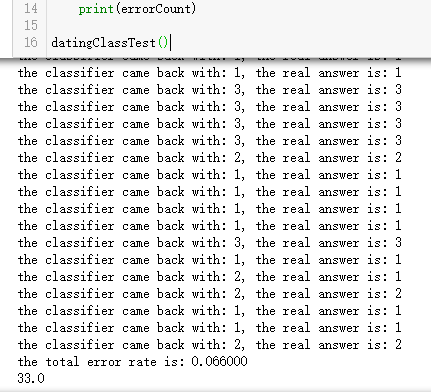在约会网站使用K-近邻算法

准备数据:从文本文件中解析数据
海伦收集约会数据巳经有了一段时间,她把这些数据存放在文本文件(1如1^及抓 比加 中,每
个样本数据占据一行,总共有1000行。海伦的样本主要包含以下3种特征:
每年获得的飞行常客里程数
玩视频游戏所耗时间百分比
每周消费的冰淇淋公升数
将文本记录到转换NumPy的解析程序
import operator from numpy import * from os import listdir def file2matrix(filename): fr = open(filename) numberOfLines = len(fr.readlines()) #get the number of lines in the file returnMat = zeros((numberOfLines,3)) #prepare matrix to return classLabelVector = [] #prepare labels return fr = open(filename) index = 0 for line in fr.readlines(): line = line.strip() listFromLine = line.split(' ') returnMat[index,:] = listFromLine[0:3] classLabelVector.append(int(listFromLine[-1])) index += 1 return returnMat,classLabelVector returnMat,classLabelVector = file2matrix('F:\machinelearninginaction\Ch02\datingTestSet2.txt') print(returnMat) print(classLabelVector)

现在已经从文本文件中导人了数据,并将其格式化为想要的格式,接着我们需要了解数据的
真实含义。当然我们可以直接浏览文本文件,但是这种方法非常不友好,一般来说,我们会采用
图形化的方式直观地展示数据。下面就用?^1!(瓜工具来图形化展示数据内容,以便辨识出一些数
据模式。

import matplotlib import matplotlib.pyplot as plt from numpy import * fig = plt.figure() ax = fig.add_subplot(111) datingDataMat,datingLabels = file2matrix('F:\machinelearninginaction\Ch02\datingTestSet2.txt') #ax.scatter(datingDataMat[:,1], datingDataMat[:,2]) ax.scatter(datingDataMat[:,1], datingDataMat[:,2], 15.0*array(datingLabels), 15.0*array(datingLabels)) ax.axis([-2,25,-0.2,2.0]) plt.xlabel('Percentage of Time Spent Playing Video Games') plt.ylabel('Liters of Ice Cream Consumed Per Week') plt.show()

import matplotlib import matplotlib.pyplot as plt from numpy import * from matplotlib.patches import Rectangle n = 1000 #number of points to create xcord1 = []; ycord1 = [] xcord2 = []; ycord2 = [] xcord3 = []; ycord3 = [] markers =[] colors =[] fw = open('E:\testSet.txt','w') for i in range(n): [r0,r1] = random.standard_normal(2) myClass = random.uniform(0,1) if (myClass <= 0.16): fFlyer = random.uniform(22000, 60000) tats = 3 + 1.6*r1 markers.append(20) colors.append(2.1) classLabel = 1 #'didntLike' xcord1.append(fFlyer); ycord1.append(tats) elif ((myClass > 0.16) and (myClass <= 0.33)): fFlyer = 6000*r0 + 70000 tats = 10 + 3*r1 + 2*r0 markers.append(20) colors.append(1.1) classLabel = 1 #'didntLike' if (tats < 0): tats =0 if (fFlyer < 0): fFlyer =0 xcord1.append(fFlyer); ycord1.append(tats) elif ((myClass > 0.33) and (myClass <= 0.66)): fFlyer = 5000*r0 + 10000 tats = 3 + 2.8*r1 markers.append(30) colors.append(1.1) classLabel = 2 #'smallDoses' if (tats < 0): tats =0 if (fFlyer < 0): fFlyer =0 xcord2.append(fFlyer); ycord2.append(tats) else: fFlyer = 10000*r0 + 35000 tats = 10 + 2.0*r1 markers.append(50) colors.append(0.1) classLabel = 3 #'largeDoses' if (tats < 0): tats =0 if (fFlyer < 0): fFlyer =0 xcord3.append(fFlyer); ycord3.append(tats) fw.close() fig = plt.figure() ax = fig.add_subplot(111) #ax.scatter(xcord,ycord, c=colors, s=markers) type1 = ax.scatter(xcord1, ycord1, s=20, c='red') type2 = ax.scatter(xcord2, ycord2, s=30, c='green') type3 = ax.scatter(xcord3, ycord3, s=50, c='blue') ax.legend([type1, type2, type3], ["Did Not Like", "Liked in Small Doses", "Liked in Large Doses"], loc=2) ax.axis([-5000,100000,-2,25]) plt.xlabel('Frequent Flyier Miles Earned Per Year') plt.ylabel('Percentage of Time Spent Playing Video Games') plt.show()

准备数据:归一化数值

我们很容易发现,上面方程中数字差值最大的属性对计算结果的影响最大,也就是说,每年
获取的飞行常客里程数对于计算结果的影响将远远大于表2-3中其他两个特征—— 玩视频游戏的
和每周消费冰洪淋公升数—— 的影响。而产生这种现象的唯一原因,仅仅是因为飞行常客里程数
远大于其他特征值。但海伦认为这三种特征是同等重要的,因此作为三个等权重的特征之一,飞
行常客里程数并不应该如此严重地影响到计算结果。

在处理这种不同取值范围的特征值时,我们通常采用的方法是将数值归一化,如将取值范围
处理为0到1或者-1到1之间。下面的公式可以将任意取值范围的特征值转化为0到1区间内的值:

其中min 和max乂分别是数据集中的最小特征值和最大特征值。虽然改变数值取值范围增加了
分类器的复杂度,但为了得到准确结果,我们必须这样做。
增加一个
新函数抓autoNorm该函数可以自动将数字特征值转化为0到1的区间。
def autoNorm(dataSet): minVals = dataSet.min(0) maxVals = dataSet.max(0) ranges = maxVals - minVals normDataSet = zeros(shape(dataSet)) m = dataSet.shape[0] normDataSet = dataSet - tile(minVals, (m,1)) normDataSet = normDataSet/tile(ranges, (m,1)) #element wise divide return normDataSet, ranges, minVals normDataSet, ranges, minVals = autoNorm(returnMat) print(normDataSet)

测试算法:作为完整程序验证分类器
机器学习算法一个很
重要的工作就是评估算法的正确率,通常我们只提供已有数据的90%作为训练样本来训练分类
器 ,而使用其余的10%数据去测试分类器,检测分类器的正确率。
10%的测试数据应该
是随机选择的,由于海伦提供的数据并没有按照特定目的来排序,所以我们可以随意选择10%数
据而不影响其随机性.
前面我们巳经提到可以使用错误率来检测分类器的性能。对于分类器来说,错误率就是分类
器给出错误结果的次数除以测试数据的总数,完美分类器的错误率为0,而错误率为1.0的分类器
不会给出任何正确的分类结果。代码里我们定义一个计数器变量,每次分类器错误地分类数据,
计数器就加1, 程序执行完成之后计数器的结果除以数据点总数即是错误率。
分类器针对约会网站的测试代码
def datingClassTest(): hoRatio = 0.50 #hold out 10% datingDataMat,datingLabels = file2matrix('F:\machinelearninginaction\Ch02\datingTestSet2.txt') #load data setfrom file normMat, ranges, minVals = autoNorm(datingDataMat) m = normMat.shape[0] numTestVecs = int(m*hoRatio) errorCount = 0.0 for i in range(numTestVecs): classifierResult = classify0(normMat[i,:],normMat[numTestVecs:m,:],datingLabels[numTestVecs:m],3) print("the classifier came back with: %d, the real answer is: %d" % (classifierResult, datingLabels[i])) if (classifierResult != datingLabels[i]): errorCount += 1.0 print("the total error rate is: %f" % (errorCount/float(numTestVecs))) print(errorCount) datingClassTest()

算法预测错误率大约是:6.6%,算是很不错的了。
使用算法:构建完整可用系统
上面我们已经在数据上对分类器进行了测试,现在终于可以使用这个分类器为海伦来对人们
分类。我们会给海伦一小段程序,通过该程序海伦会在约会网站上找到某个人并输入他的信息。
程序会给出她对对方喜欢程度的预测值。
def classifyPerson(): resultList = ['not at all','in small doses1','in large doses'] percentTats = float(input("percentage of time spent playing video games?")) ffMiles = float(input("freguent flier miles earned per year?")) iceCream = float(input('liters of ice cream consumed per year?')) datingDataMat,datingLabels = file2matrix('F:\machinelearninginaction\Ch02\datingTestSet2.txt') normMat, ranges, minVals = autoNorm(datingDataMat) inArr = array([ffMiles, percentTats, iceCream]) classifierResult = classify0((inArr-minVals)/ranges,normMat,datingLabels,3) print("You will probably like this person:",resultList[classifierResult - 1]) classifyPerson()
